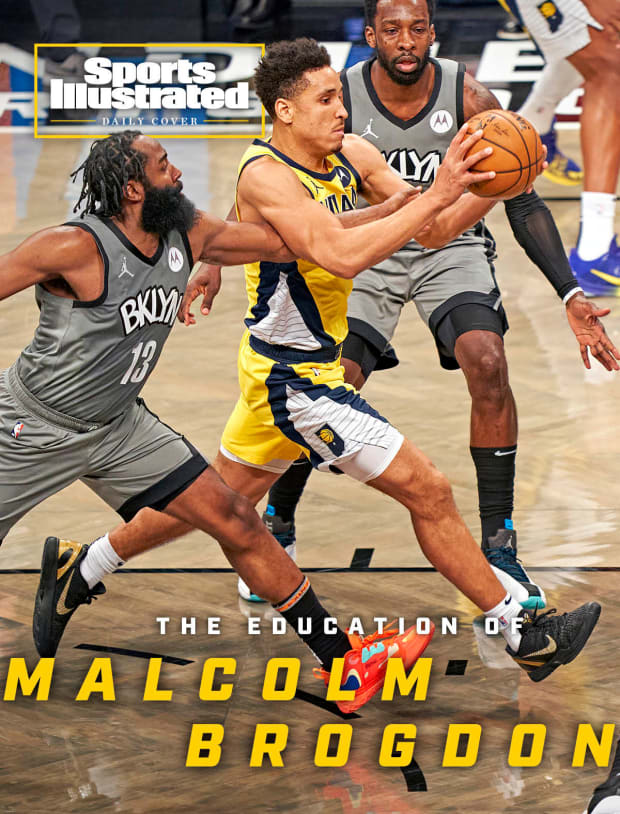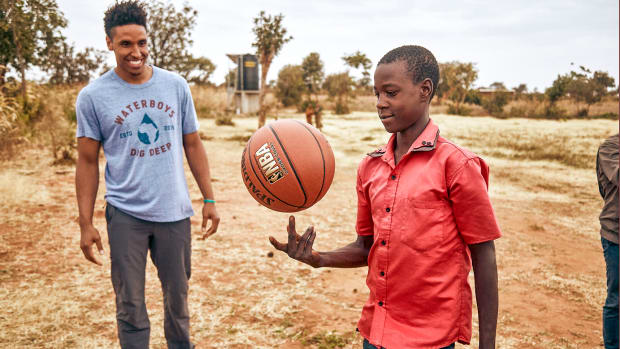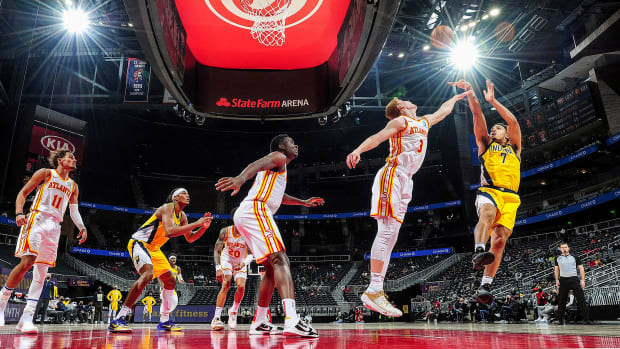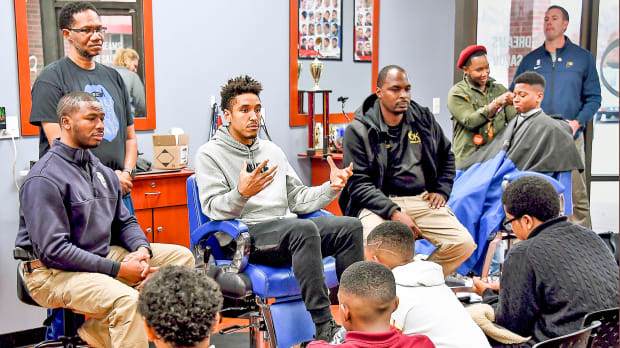The Pacers (for now, at least) guard wants to learn all about his game—and his family's legacy of activism.
On Feb. 14, fresh off an 18-point, eight-assist, ho-hum-for-him line in a 125–113 win at Atlanta, Pacers guard Malcolm Brogdon shared a new Instagram post to his 137,000-plus followers. The picture showed him striding through the Hawks’ downtown arena the previous night, clad in a KF94 medical mask and a dark hoodie that read MADE IN ATLANTA. The caption featured this same slogan in hashtag form, flanked by a peach emoji and a simple yet heartfelt note: “Always good to be home.”
From age eight to 13, home for Brogdon was the two-story colonial at 547 Auburn Avenue, just off the corner of Howell Street, two miles east of the Hawks’ arena. His family arrived there from the suburbs in 2001, and his parents, Jann Adams and Gino Brogdon Sr., promptly built a basketball court behind the house for their three sons. Really, it was little more than a concrete slab the width of a minivan, marked by a right wing that spilled into a nearby driveway and a hoop weighed down by bricks at the base. “At the time it didn’t seem tiny,” says Malcolm. “We just got a lot of use out of it.”
Back then, Brogdon says, he was a “rambunctious kid,” nicknamed Mookie Dew by his dad for the way he zipped around à la Mookie Blaylock, the Hawks’ 6-foot jetpack. Naturally this led to the occasional injury, including an upper incisor that remains chipped thanks to a neighborhood friend’s hard foul. More often, though, Malcolm trudged inside for dinner with invisible scars, gushing tears because older brothers Gino Jr. and John would never let him win. “Taking a beating every day, physically and mentally, that takes a toll on you,” he says. “And it either grows you up or . . . it makes you sort of a passive kid. And I was not going to be a passive kid.”

An identity formed on the pavement behind 547 Auburn. He learned the toughness required to bulldoze into a lane of NBA bigs at 6' 5" and the craftiness he flashes with every fake dribble handoff along the perimeter. He developed the gumption necessary to separately posterize Kyrie Irving and LeBron James in a December 2016 game as a Bucks rookie, and the patience he exercises alongside Pacers center Domantas Sabonis to form one of the league’s most prolific pick-and-roll tandems today. He even shed the youthful exuberance of Mookie Dew, adopting a stoic demeanor that betrays as much emotion on the court as the ball itself. “Reminds me a little bit of some Kawhi-type s---,” says Pelicans guard Eric Bledsoe. “You can’t get him riled up, no matter how many times you try to be physical, or talk trash. He always has that same look. Calm and unbothered.”
But those five years of childhood paved the way for Brogdon to become more than the point guard who is averaging career highs of 35.6 minutes and 21.6 points through 40 games, along with 6.1 assists and 4.7 rebounds, while helping Indiana survive without starting wings T.J. Warren (foot surgery) and Caris LeVert (kidney cancer). They explain how he developed a desire to serve, now reflected in a seat on the NBPA’s executive committee and a philanthropic portfolio spanning two continents. And how he has found his voice as an activist for social justice, carrying on the deep legacies of his neighborhood, his family and his name.
And why, a little while after Brogdon uploaded the picture from the Hawks game, Gino Jr. reposted it on his story feed but modified the text on his brother’s sweatshirt to display a new message: MADE ON AUBURN AVE.
During the 1930s and ’40s, in the neighborhood known as Sweet Auburn—so named for the prosperous banks, restaurants, funeral parlors, dry cleaners and other Black-owned commercial properties along the bustling main drag—children often congregated on the basketball court in the rear yard of Fire Station No. 6, where they hoisted shots to a soundtrack of sirens. Among the regular hoopers was a boy named Martin Luther King Jr., whose family worshipped in Ebenezer Baptist Church and lived at 501 Auburn, both less than a block away.
Much had changed by the time Brogdon and his family moved down the street. The firehouse and Ebenezer Baptist still stood on a designated historic site honoring King, but rising poverty had also displaced portions of the historically Black population. “The neighborhood was definitely mixed,” Brogdon says. “You had people that were middle-class, and then you had a lot of unhoused people who were really struggling.” As it was in King’s day, though, all were welcome on the court. “It’s easy to be uncomfortable or not want to be around people who are on the street, or people who have addiction problems,” Brogdon says. “But I think a lot of us fail to see the humanity in them. . . . You can form relationships and friendships with those people, too. A lot of the people that would walk by our house every day, they would stop and play basketball.”
Living on Auburn Avenue was far from Brogdon’s only exposure to the world’s inequalities. His mother recalls a family service trip to Ghana when Malcolm was in elementary school, during which he worked at a dingy outdoor daycare located next to a garbage dump. “The trucks would drive right by the playground,” says Adams, a psychology professor at Morehouse and director of the college’s global leadership center. “The poverty there, he’d never seen anything like that. I think that was the first wake-up call for Malcolm.” A few years later he went to Malawi with his maternal grandparents, Dolly and John Hurst Adams, sparking an interest in clean-water initiatives that endures through his foundation’s work installing drinking wells in remote villages across Africa.

So began a dedication to public service that goes back generations. In the 1920s, great-grandfather Eugene Avery Adams Sr. helped launch the first statewide civil rights organization in segregated South Carolina and served as a branch president for the NAACP. In the ’50s, John Hurst Adams, then president of Paul Quinn College in Waco, Texas, backed student sit-ins to combat segregation and drove vanloads of students to hear King, his old Boston University theology classmate, speak.
The year of King’s death, 1968, Dolly and John moved with their three young daughters, Gaye, Jann and Madelyn, from Seattle, where John had organized protests for fair housing and cofounded the country’s first war-on-poverty agency, to Los Angeles. There John worked as pastor of Grant AME in the Watts neighborhood, which had been famously rocked by civil unrest and riots three years earlier, and Dolly ran a Saturday school at the church that provided free meals and emphasized Black history. “The older I get, the more I think about how all these things are connected,” Jann says. “I think Malcolm is part of that connection.”
John Hurst Adams died on Jan. 10, 2018, at 90, the same day Brogdon had 14 points, nine assists and seven rebounds for the Bucks in a win over Orlando. The memorial was held 10 days later at Atlanta’s Flipper Temple AME Church. It was the first time Brogdon had ever dealt with the death of someone so close. “It’s like the leader of the family’s gone,” Brogdon says. “It’s a seat that will never be filled.”
He is taking a page from his Poppo nonetheless. As a rookie second-round pick out of Virginia in 2016, Brogdon surprised teammates when he volunteered during an early-season NBPA meeting to become Milwaukee’s union rep. “He was the first one to raise his hand,” former Bucks guard Jason Terry says. “That was rare. A lot of guys are thrust into that position because vets don’t want to go to the meetings. It speaks volumes to him and his character.” The following summer, not long after he became the first non-first-rounder since 1958 to win Rookie of the Year, Brogdon joined an NBPA panel for some 90 draft prospects. “The program ended, and a couple of us were still milling about, because there was still food there,” says NBPA director Michele Roberts. “Half an hour, 45 minutes later, there’s Malcolm, still surrounded by eight to 10 prospects, answering questions.”
Finding his voice on bigger issues took more time. “I’m a very private person,” Brogdon says. “I can be antisocial. But when it comes to things I’m extremely passionate about, which is only a few things in life, that’s the stuff I’m willing to speak out on.” One such passion was seeded several summers ago, when Brogdon and his mother visited the Montgomery, Ala., museum of the Equal Justice Initiative, a nonprofit that fights mass incarceration. “I’m really into [learning about] the prison system and the criminalization of Black men and women, and the stereotypes that go along with it,” Brogdon says. “The system is designed against us. The system is designed to target us and to criminalize us for marijuana and absolutely nothing. This is the new slavery. This is the new Jim Crow.”

For Brogdon, this education culminated in action last May 30, 2 ½ months after the NBA paused its season and five days after white Minneapolis police officer Derek Chauvin killed George Floyd by kneeling on the 46-year-old Black man’s neck. That morning, Brogdon awoke at his offseason home on the north side of Atlanta, worked out, slipped on a black T-shirt that he’d bought on his visit to the Equal Justice Initiative and drove to Auburn Avenue.
Right down the block from his childhood home, across the street from Fire Station No. 6, a hundred masked protesters were clustered outside the fountain at the King Center, the centerpiece of what is now Martin Luther King Jr. National Historical Park. The gathering was organized by Celtics guard Jaylen Brown, a fellow Atlanta-area native. Soon the group began to march—down Auburn Avenue, through downtown Atlanta, in and out of the Georgia State campus, about two miles total before they stopped and turned back.
At about the halfway point, Brown asked Brogdon whether he wanted to address the crowd. Brogdon balked. “It wasn’t something I intended on doing, and it wasn’t something I actually wanted to do,” he explains. But he relented, speaking into a megaphone for about a minute, as former Virginia teammate Justin Anderson rested a hand on his shoulder. “I just said what was on my mind, on my heart,” Brogdon says. “Honestly, I don’t think it came out the best. But it was authentic.”
No more so than when he shouted out his grandfather and other civil rights contemporaries for laying the groundwork atop which Brogdon and his peers walked tall. “I think the most important thing I said was, all of us have elders and ancestors that have been marching for us and for our people for hundreds of years,” he says now. “They laid the groundwork for us. And I think it’s incredibly important for us to be appreciative and grateful for them . . . laying down their lives so that we can live better ones. And basically to continue the legacy, to keep pushing forward.”

One day last summer Roberts was strolling past the swimming pool inside the NBA bubble at Disney World when she caught an unusual sight. “Some guys were in the pool playing volleyball, or sitting poolside listening to music,” says Roberts, 65. “And there’s Malcolm, reading a book. Not on a device. A hard book. I remember thinking, ‘Damn, who does that except people in their 50s and 60s?’ ”
The book was The Autobiography of Malcolm X, which had come in a care package provided by the union to players when the season resumed in late July. Brogdon didn’t finish all 500-plus pages before the Pacers were swept by Miami in their first-round playoff series, during which he averaged team highs of 21.5 points and 10.0 assists. But he had already read his namesake’s life story once before.
“I’m not sure there’s any other person in history that transformed themselves and transformed their minds the way Malcolm X did,” Brogdon says. “There’s nothing that makes me more proud to be named after him.” Asked what he has taken away from Malcolm X’s teachings, Brogdon doesn’t hesitate: “I would just say how Malcolm X equipped himself with education. He has a quote that education is your passport to the future. And for Malcolm X, you equip your mind before you equip anything else.”
Brogdon’s family carries a similar credo. A great-aunt on his mother’s side, Lucy Rose Adams, earned two advanced degrees and chaired business departments at two colleges; another, Charity Edna Adams, earned a master’s in psychology after serving in the U.S. Army as its highest-ranking Black woman during World War II. John Hurst Adams enrolled at Johnson C. Smith at the age of 15 and lettered in four sports, including basketball. After Brogdon committed to Virginia out of Greater Atlanta Christian High, his in-home recruiting visit with Cavaliers coach Tony Bennett was punctuated when his grandmother piped up, “Well, if it were up to me, he would go to Harvard!”
Brogdon was always a dedicated student. One of his professors, Gerry Warburg, recalls Brogdon’s sending him a draft of a term paper about U.S. aid to Africa while riding home on the team bus from Washington after a loss to North Carolina in the 2016 ACC title game. “He was constantly challenging himself with the hardest assignments,” Warburg says. “The discipline from the basketball court translated into his work in the classroom.”
In ninth grade, around the time that his parents divorced and the family moved out of 547 Auburn, Brogdon felt something “really click” inside his basketball consciousness. He began training daily with his older brother John after school, and beat the sun on Sunday mornings to heave jumpers before church. He swore to himself that no one in his recruiting class would outwork him, and to this day maintains no one did. “It never stopped,” he says. “It never slowed down.”
Not when he enrolled in Charlottesville, where a student manager once developed tendinitis in both wrists from feeding Brogdon during shooting drills. And not even when Brogdon broke his left foot as a freshman, causing him to take a redshirt season. “He had this rolly chair that he could wheel around on with his leg propped up in a boot,” says Nets guard Joe Harris, a college teammate. “He’d always scoot around at practice doing ballhandling stuff.”
Away from the gym Brogdon was no less intense. Wizards forward Anthony Gill, his college roommate for two years, recalls how Brogdon would finish dinner and then devour a whole steamable bag of broccoli. “‘Malcolm, that’s not a dessert,’” Gill would say, to which Brogdon replied, “Yeah, but it gives me an edge.” In early summer 2016, as he and Brogdon were prepping for the NBA draft, Gill was getting married, and Brogdon was a groomsman. The rehearsal dinner was held at a warehouse brewery in Charlotte, and guests dined on fried chicken and syrupy waffles. “He ended up leaving the rehearsal dinner early, because he had to get some healthy food,” says Gill. “He has goals in mind, and he’s gonna accomplish them.”
Brogdon took his education to another level after last season, his first with the Pacers after a June 2019 sign-and-trade that yielded three picks for Milwaukee and a four-year, $85 million contract for Brogdon. “I’m all in the details now,” he says. “I’m a guy that has a lot of opportunity to make a lot of money in a short period of time. And I think I’d be wasting a lot of money if I did not put the effort and thought and research behind it. I’m not a guy that is going to be jumping over people or speeding around people. I have to maximize what I have and make sure that the tank is full so that I can do that.”
A blood test revealed that his digestive system was sensitive to cod, salmon and barley, so he eliminated those foods from his diet. (Broccoli remains on the menu.) A physical therapist, Karen Warren, advised him on the importance of hydration and sleep hygiene, so now he drinks a gallon and a half of water a day, avoids electronic devices at night and awakens to natural light whenever possible. He also started performing 15 minutes of yoga before bed and begins every day by slipping on a finger sensor to measure his heart-rate variability on an app. “It [tells me] whether my body is more parasympathetic, or in the sympathetic stage,” Brogdon says. “That’s how I know if I’m overworking my body, or if my body is still asleep and I need to wake it up and stimulate my nervous system.”
In past seasons, Brogdon would write down specific statistical goals for himself. “Points, assists, steals, yada yada,” he says. Entering his second year in Indiana, though, he ditched that tradition. “This season I said I want to have a hell of a season, a breakout year, but one of my biggest goals is to stay healthy,” he says. “I’m putting all this work and all this mental energy and focus on my diet and my body. If I can stay healthy, I really think the sky’s the limit.”

As the sun set outside at his Indianapolis home, Brogdon fumed. This was Jan. 24, hours after a daytime 107–102 loss to the Raptors at Bankers Life Fieldhouse where he shot 5 for 22 from the field and 1 for 10 from deep.For a time he devoured film of the defeat alone, scheming ways to break Toronto’s swarming defensive pressure when the teams met again the next night. Then he got a text from first-year coach Nate Bjorkgren, wondering how he was feeling. One message turned into a thread, and soon the thread gave way to a call. “We spoke late that night,” Bjorkgren says. “Things that we wanted to do differently as a team, things that I thought he should do differently.”
Brogdon stayed up through the night, frustration stifling sleep. But he channeled his emotions into pummeling the Raptors with 36 points, nine assists and seven rebounds in a 129–114 rout. “Constantly in attack mode on both ends of the floor,” Bjorkgren says. “He was relentless.”
To hear Brogdon tell it, he has found a kindred communicative spirit in his fifth NBA coach. The seeds of their relationship were planted last fall, when they met for lunch in Atlanta at a café specializing in comfort food. Brogdon emerged impressed with Bjorkgren’s “contagious energy” and the potential that it had to “enhance our culture.”
In Brogdon’s estimation, Bjorkgren has delivered on all fronts, from playing music in practice to mixing up drills. “We have a shared belief that communication is the road to success,” Brogdon says. “I’d rather have too much information than not enough information.” As their late-night call suggests, their talks are two-way streets; Brogdon isn’t shy about asking to guard an opponent’s best player. “It’s hard to say no when your leader says that,” Bjorkgren says. “So I grant him that wish and say, ‘Go get ’em.’”
The chance to lead helped Brogdon reconcile his depar- ture from Milwaukee when the Bucks decided against entering the luxury tax to pay him as a restricted free agent, even though he was coming off a historic season when he joined Stephen Curry and Kevin Durant as the only active members of the NBA’s 50-40-90 shooting club. “It was Giannis’s team, it was Khris Middleton’s team,” Brogdon says. “It was part of my growth, playing in Milwaukee, playing with these guys. But at the same time, it was part of my growth to leave.”
Brogdon has been embraced by Indy. Team president Kevin Pritchard called the signing “one of the best days in franchise history.” On the floor Brogdon barks out plays and coverages with an Obamian baritone that famously led former Virginia teammates to nickname him the President. Off it, Brogdon says, he is consulted about personnel decisions and other issues that signal his importance to the Pacers’ future. “I think the reality in the NBA is that the majority of guys play on teams where they don’t feel valued, unless you’re a top-five player,” Brogdon says. “But I’ve been blessed to be on a team where I am.”
(A few weeks later, following a stretch in which the Pacers lost nine of 13 to fall into 10th place in the East, one rumor-mill report declared that Indy was “listening to pitches” on Brogdon ahead of tomorrow’s trade deadline.)
His charitable efforts have kicked into another gear, too. Last July he launched the Brogdon Family Foundation, with his mother serving as executive director and two main programs on the docket. One is the John Hurst Adams Education Project, which partners with seven (and counting) Indianapolis-area schools on literacy initiatives and aims to conduct tours of HBCU campuses for its students in spring 2022. The other, Hoops4Humanity, builds up schools in Tanzania and Kenya with infrastructure around newly dug freshwater wells, such as indoor handwashing stations and bathrooms, and furnishes students with learning tablets and basketball courts. “Water is a great blessing, a great resource, but there’s so much more need and so much more you can do to help,” he says.
Once or twice each offseason, Brogdon meets his family for dinner around historic Krog Street Market, a half-mile from their old Sweet Auburn home. Each time, he always takes a detour to the neighborhood. “Just to see the history that I grew up around,” he says.
He cruises past Fire Station No. 6, where the basketball hoop is long gone but the red-brick building stands tall. He gazes at Ebenezer Baptist Church, and the Queen Anne at 501 Auburn, and the national park where King’s tomb now rests near an eternal flame and a rose garden. He idles outside 547 Auburn, reliving his battles atop the concrete slab, and thinks about those who balled on the block before him. “I feel proud and privileged to have grown up in that area,” Brogdon says.
Then he drives away, off to continue the legacy, off to keep pushing forward.